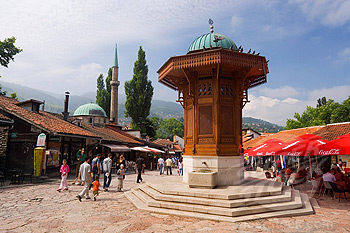Baščaršija
Baščaršija is Sarajevo’s old bazaar and the historical and cultural center of the city. Baščaršija was built in the 15th century when Isa-Beg Isaković founded the town.
The word Baščaršija derives from the Turkish language. The word “baš” which is “baş” in Turkish literally means “head”, in some contexts however also “primary”, “main”, “capital” and “čaršija” which is “çarşı” in Turkish means “bazaar” or “market”. Due to the large fire in the 19th century, today Bascarsija is half the size that it once was. Due to the large fire in the 19th century, today Baščaršija is half the size that it once was.
Baščaršija is located on the north bank of the river Miljacka, in the municipality of Stari Grad. On Baščaršija there are several important historic buildings, such as the Gazi Husrev-beg Mosque and sahat-kula. Today Baščaršija is the major tourist attraction of Sarajevo.
The Gazi Husrev-bey Mosque
The Gazi Husrev-bey Mosque (Bosnian: Gazi Husrev-begova Džamija), is a mosque in the city of Sarajevo, Bosnia and Herzegovina. It is considered the most important Islamic structure in the country and one of the world’s finest examples of Ottoman architecture. It is located in the Baščaršija neighborhood in the Stari Grad municipality, and remains one of the most popular centers of worship in the city.
The Gazi Husrev-beg Mosque was built by the famous Ottoman architect Acem Esir Ali “Alaüddin”,who also built the Yavuz Selim Mosque in Istanbul for the Sultan Selim I. The mosque was financed in 1531 by Gazi Husrev-beg, the provincial governor of Bosnia and Sultan Beyazid II’s grandson. Gazi Husrev-beg is widely considered Sarajevo’s greatest patron, as he financed much of Sarajevo’s old city at this time.
Tunel Spasa Museum – Sarajevo (Dobrinja – Kotorac)
The Sarajevo Tunnel was constructed between May 1992 and November 1995, during the Siege of Sarajevo in the midst of the Bosnian War. It was built by the Bosnian Army in order to link the city of Sarajevo, which was entirely cut-off by Serbian forces, with Bosnian-held territory on the other side of the Sarajevo Airport, an area controlled by the United Nations. The tunnel linked the Sarajevo neighbourhoods of Dobrinja and Butmir, allowing food, war supplies, and humanitarian aid to come into the city, and people to get out. The tunnel became a major way of bypassing the international arms embargo and providing the city defenders with weaponry.
Grave of the President Alija Izetbegovic
Alija Izetbegović (Bosnian pronunciation: [alija izɛtbɛɡɔʋitɕ]) (8 August 1925 – 19 October 2003) was a Bosniak politician, activist, lawyer, author, and philosopher who in 1990 became the first Chairman of the Presidency of Bosnia and Herzegovina. He served in this role until 1996, when he became a member of the Presidency of Bosnia and Herzegovina, serving until 2000. He was also the author of several books, most notably Islam Between East and West and the Islamic Declaration.
 Sarajevo, Ilidza – Vrelo Bosne
Sarajevo, Ilidza – Vrelo Bosne
Vrelo Bosne is the spring of the River Bosna located in the central region of Bosnia and Herzegovina, southwest of Sarajevo. It is one of the country’s top natural landmarks and is one of the most famous scenes of natural beauty in the region.
The park is usually entered by foot or, for a reasonable price, by horse-carriage via the main avenue leading into it. The avenue itself contains traditional buildings from the Austro-Hungarian-era offering a peek into the luxuries of the past.


